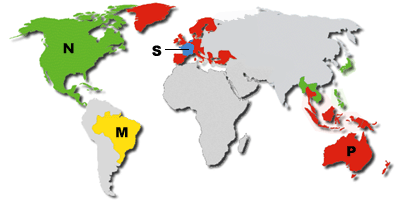|
|
|
TV Format Key Explained
 There
are three general world standards for video: PAL, NTSC and SECAM. These
standards are mostly incompatible which means that you might not be able
to play games from other countries on your standard TV set. The consoles
themselves do not differentiate between video formats - the only difference
is the way the game is programmed and the TV set used to display it. PAL
games must be played on PAL TV's, NTSC games must be played on NTSC TV's,
etc. However, some recent TV's will play multiple formats, so please don't
assume that just because a game displays on your TV that it is of your
local video format. There
are three general world standards for video: PAL, NTSC and SECAM. These
standards are mostly incompatible which means that you might not be able
to play games from other countries on your standard TV set. The consoles
themselves do not differentiate between video formats - the only difference
is the way the game is programmed and the TV set used to display it. PAL
games must be played on PAL TV's, NTSC games must be played on NTSC TV's,
etc. However, some recent TV's will play multiple formats, so please don't
assume that just because a game displays on your TV that it is of your
local video format.
The difference between formats is mainly of scanlines, framerate, frequency,
and color. PAL systems tend to look sharper with better resolution, while
NTSC systems tend to have less flicker since they run at a higher framerate. Playing a PAL game on an NTSC TV
might result in the screen rolling or the colors being decidedly off.
| Icon |
Format |
Description |
|
|
NTSC |
The first color TV broadcast system was implemented in the
United States in 1953. This was based on the NTSC (National
Television System Committee) standard. NTSC is used in all
of North and Central America, the Philippines, South Korea
and Japan.
Scanlines: 525
Frame Rate: 30 FPS
Frequency: 60 Hz
|
|
|
PAL |
The PAL (Phase Alternating Line) standard
was introduced in the early 1960's and implemented in most European
countries except for France. The PAL standard utilizes a wider
channel bandwidth than NTSC which allows for better picture
quality. Variations on the PAL system are PAL B,G,H - PAL I
- PAL D - PAL N & PAL M. PAL is used in most of Europe,
Scandinavia, parts of Asia, the Pacific and Southern Africa.
Scanlines: 625
Frame Rate: 25 FPS
Frequency: 50 Hz
|
|
|
PAL-M |
PAL-M is used exclusively in Brazil, and
is a hybrid of NTSC and PAL. PAL-M uses the same scanlines,
frequency, and frame rate as NTSC, but uses a PAL color pallette.
Keep in mind that this is the video format used by the TV, to
our knowledge there aren't any cartridges actually programmed
for PAL-M. This means that NTSC games will display on a PAL-M
TV but the color may be different from that of an NTSC TV. Therefore,
we have listed Brazilian games as being in NTSC format, even
though the Brazilian video standard is PAL-M. Brazilian games
should play fine on North American TV's.
Scanlines: 525
Frame Rate: 30 FPS
Frequency: 60 Hz
|
|
|
SECAM |
The SECAM (Sequential Couleur Avec Memoire
or Sequential Colour with Memory) standard was introduced in
the early 1960's and implemented in France. SECAM uses the same
bandwidth as PAL but transmits the color information sequentially.
It is used in France, Russia, C.I.S., the Middle East and Northern
Africa.
Scanlines: 625
Frame Rate: 25 FPS
Frequency: 50 Hz
|
|
|

